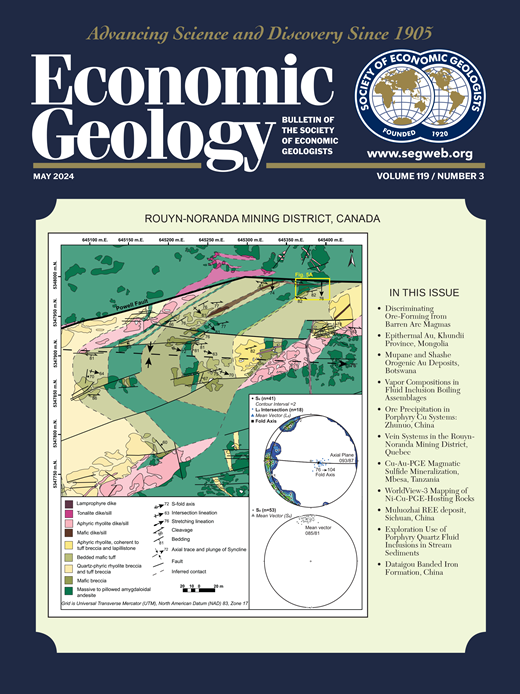Volcano-Sedimentary Lithium Occurrences in Barstow, California, and Their Related Formation Mechanisms Determined by Stable Isotope Analyses of Carbonates and Clays
IF 4.9
1区 地球科学
Q1 GEOCHEMISTRY & GEOPHYSICS
引用次数: 0
Abstract
The production of lithium (Li) from underexplored volcano-sedimentary Li deposits could increase the Li stockpile for the future while diversifying the available sources of Li needed for the energy transition. Here, we investigate the occurrence, distribution, and potential enrichment mechanisms for recently discovered Li-rich mudstones within the Miocene Barstow Formation in the Mojave Desert of California. Bulk mudstone Li concentrations from the Barstow Formation range from 20 to 2,500 ppm, and the most enriched samples correspond to a greater proportion of smectite relative to illite, chlorite, and kaolinite. The Li-enriched mudstones tend to contain analcime, calcite, dolomite, and feldspar. Bulk mudstone Li concentrations covary with the oxygen isotope composition of the carbonate phases (δ18Ocarb; 17–35‰ Vienna standard mean ocean water). Smectite δ18O values mirror paired carbonate trends and contain an evaporitic slope in δ18O-δD space, suggesting both minerals formed from the same evaporatively enriched evolving water reservoir. Calculated smectite formation temperatures range from 17° to 51°C and carbonate clumped isotope formation temperatures range from 15° to 50°C, suggesting low-temperature processes drive Li enrichment. The combined geochemical and stable isotope results suggest that between 19 and 13 Ma, evaporation of ephemeral underfilled to perennial balance-filled lake waters led to the Li enrichment of pore waters and subsequent Li smectite authigenesis. We speculate the primary source of Li to ancient lake/pore waters came from the weathering of glassy volcanic ash shards to the lake and aqueous Li weathered from coeval felsic volcanic rocks in and around the Barstow basin. Evidence for Li-rich hydrothermal contributions to lake/pore waters is minor. Our study suggests that other deposits set in nearby extensional regimes may have had similar paleoenvironmental controls surrounding the formation of authigenic, Li-rich smectite.加州Barstow火山-沉积锂矿床及其相关形成机制由碳酸盐和粘土稳定同位素分析确定
从未开发的火山-沉积锂矿床中生产锂(Li)可以增加未来的锂储量,同时使能源转型所需的可用锂来源多样化。本文研究了加州莫哈韦沙漠中新世Barstow组中新世富锂泥岩的赋存、分布及其富集机制。Barstow组泥岩中Li的浓度在20 ~ 2500ppm之间,富集程度最高的样品中,蒙脱石的比例高于伊利石、绿泥石和高岭石。富锂泥岩多含钙石、方解石、白云石和长石。泥岩体积Li浓度随碳酸盐相氧同位素组成(δ18Ocarb; 17 ~ 35‰维也纳标准海水)的变化而变化。蒙脱石δ18O值反映成对的碳酸盐岩走向,δ18O-δD空间呈蒸发斜坡,表明两种矿物形成于同一蒸发富集演化储层。计算的蒙脱石形成温度为17 ~ 51℃,碳酸盐团块同位素形成温度为15 ~ 50℃,表明低温过程驱动Li富集。地球化学和稳定同位素的综合结果表明,在19 ~ 13 Ma期间,短暂的湖泊欠充水到常年平衡充水的蒸发作用导致孔隙水的Li富集和随后的Li蒙脱石自生。我们推测,古湖/孔隙水中Li的主要来源是玻璃状火山灰碎屑对湖泊的风化作用,以及同期长英质火山岩对湖/孔隙水中Li的风化作用。富锂热液对湖泊/孔隙水贡献的证据较少。我们的研究表明,其他位于附近伸展区的矿床可能具有类似的古环境控制,围绕自生富锂蒙脱石的形成。
本文章由计算机程序翻译,如有差异,请以英文原文为准。
求助全文
约1分钟内获得全文
求助全文
来源期刊

Economic Geology
地学-地球化学与地球物理
CiteScore
10.00
自引率
6.90%
发文量
120
审稿时长
6 months
期刊介绍:
The journal, now published semi-quarterly, was first published in 1905 by the Economic Geology Publishing Company (PUBCO), a not-for-profit company established for the purpose of publishing a periodical devoted to economic geology. On the founding of SEG in 1920, a cooperative arrangement between PUBCO and SEG made the journal the official organ of the Society, and PUBCO agreed to carry the Society''s name on the front cover under the heading "Bulletin of the Society of Economic Geologists". PUBCO and SEG continued to operate as cooperating but separate entities until 2001, when the Board of Directors of PUBCO and the Council of SEG, by unanimous consent, approved a formal agreement of merger. The former activities of the PUBCO Board of Directors are now carried out by a Publications Board, a new self-governing unit within SEG.
 求助内容:
求助内容: 应助结果提醒方式:
应助结果提醒方式:


